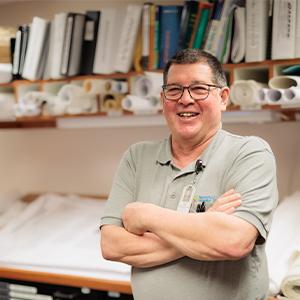David Sindelar

When David Sindelar started looking like Popeye, it was time for help.
David does a lot of physical work. So when he injured his right arm and shoulder, he shrugged it off . . . for about six months. The pain and weakness built gradually until even simple movements were hard – turning a rachet wrench, or a pepper grinder.
Then suddenly, David’s bicep bulged out like Popeye’s forearm. And it hurt. A lot. “It wasn’t going to get better on its own,” David says, so he took it to his primary care doctor, David McIntyre, MD who suspected the bicep muscle had torn away from the bone. He referred David to orthopedic surgeon Clint Muench, MD.
An MRI confirmed the torn bicep, and showed possible damage to David’s rotator cuff, the group of muscles and tendons around the shoulder joint that hold the head of the upper arm bone in the shoulder socket.
Dr. Muench recommended surgery to repair the bicep, and any damage to David’s rotator cuff. Age and activity level were both factors in choosing surgery, David recalls: “Dr. Muench said, ‘You’re active and do a lot physically, so let’s repair it.’”
They wouldn’t know the extent of rotator cuff damage until Dr. Muench could see it in surgery. It would be the difference between 12 weeks or six months of recovery.
At the same time, David was coping with carpal tunnel in both wrists. “I thought, ‘If I’m going to lose the use of my right arm and shoulder for a while, let’s get my left hand working better first,’” David says.
Dr. Muench repaired David’s left wrist, then six weeks later repaired his bicep, rotator cuff and right wrist. Both were outpatient surgeries at Northfield Hospital’s Surgery Center.
It was David’s first time in an operating room. “I knew I was in good hands,” he says of the surgery team. “My only concern was not knowing how bad the rotator cuff would be.”
Not too bad, it turns out. Dr. Muench cleaned up some arthritis and bone spurs in David’s shoulder. Recovery would be short.
Weekly physical therapy with Maria Bohl, DPT restored mobility to David’s hands and shoulder through a combination of stretches, massage, and exercises: “I’m getting more mobility every day with little pain,” he says.
“It’s like bad eyesight or hearing loss: You don’t know what you’re missing until it’s fixed.”
David still has some tingling pain from carpal tunnel as numbness from compressed nerves subsides, and sensation returns to his fingertips. “I expect that to improve over the coming months,” he says.
He’s looking forward to yard work, gardening, and playing with his grandkids.
David’s advice for men who do a lot of physical work and brush off pain: “If it doesn’t go away or it gets worse, it’s worth checking out – especially as you get older. The damage can be slow and progressive. You just don’t recover like you did when you were 20.”
Or bounce back like a cartoon character.
